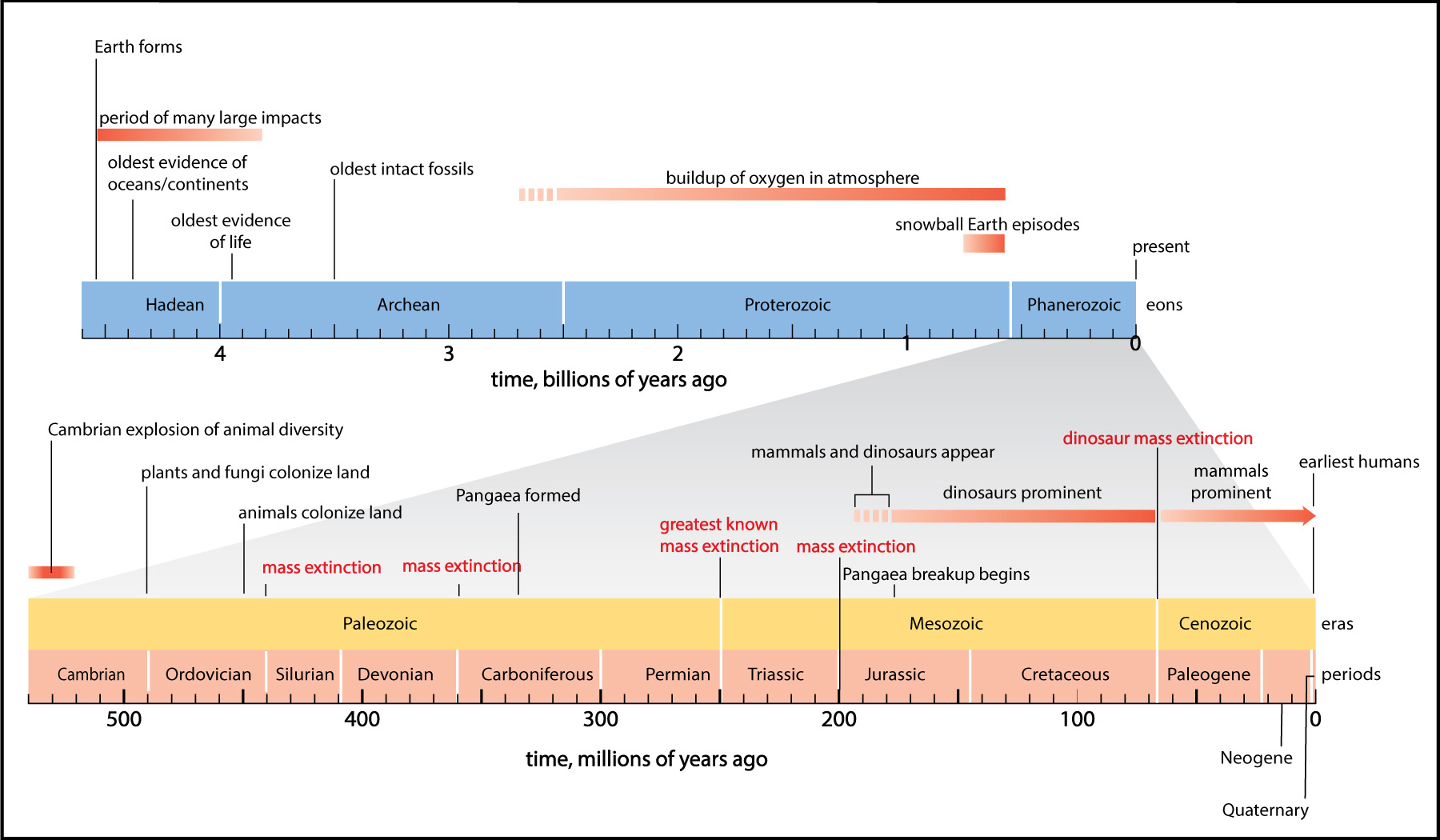
You’ve learned a lot about how planet Earth works and the changes that it has gone through over its history. To help you summarize these ideas, we’ll devote this final section of Chapter 5 to a brief geological history of our planet. In essence, we’ll “close the loop” on understanding the geological time scale that we first discussed in Chapter 4, which is repeated in Figure 5.4–1 above. We’ll also discuss in more detail the idea of mass extinctions by focusing on the one that killed off the dinosaurs, and we’ll consider how we humans are now affecting Earth’s history.
Section Learning Goals
By the end of this section, you should be able to give general answers to the following questions:
- What major changes mark Earth’s fossil record?
- What killed the dinosaurs?
- Have we humans started a new geological epoch?
Before you continue, take a few minutes to discuss the above Learning Goal questions in small groups or as a class. For example, you might discuss what (if anything) you already know about the answers to these questions; what you think you’ll need to learn in order to be able to answer the questions; and whether there are any aspects of the questions, or other related questions, that you are particularly interested in.
Discussion
The Human Epoch
Notice how Figure 5.4–1 divides our planet’s history into many different time periods. In the final subsection of this chapter (Section 5.4.3), we will consider whether we humans have caused the start of a new such time period, sometimes referred to as the “human epoch” or “Anthropocene” . To help you prepare for that discussion, work in small groups or as a class to answer the following questions.
- Thinking back to ideas we’ve already discussed, briefly state how and why scientists decide that one geological time period (like any of those shown in Figure 5.4–1) has ended and another has begun.
- What does the word epoch mean?
- Look up the origin of the word Anthropocene. Explain how it could be considered synonymous with a “human epoch.”
- The definition of the Anthropocene, or human epoch, states that humans have become a “dominant influence on Earth’s geology, climate, and life.” Give at least one example each of how we humans are making a major impact on Earth’s geology, climate, and life.
- Imagine future geologists living millions of years in the future. Do you think they would see a sudden change in the fossil record corresponding to our current time? Explain.
- Based on your answers above, explain why scientists might claim that Earth is now in a time period that we could call the human epoch or Anthropocene.
This discussion is designed to motivate thinking about the geological time scale and to prepare students for the deeper philosophical discussion of the Anthropocene that we’ll have in Section 5.4.3. Notes on the answers:
- (1) The various time periods in Earth’s history are based on observed changes in the rock or fossil record.
- (2) An epoch is a period of time that is marked by notable events or characteristics.
- (3) The word Anthropocene combines anthropo, from a Greek root meaning “human,” and cene, from a Greek root meaning “new” or “recent.” So the term Anthropocene refers to a new/recent time period in which humans are important, which essentially makes it a synonym for the “human epoch.”
- (4) There are many examples that students could cite. E.g., for geology, students could note how we transform landscapes through mining and agriculture; for climate, they could cite global warming or the way cities influence local weather; for our influence on life, students could cite how we have driven many species to extinction and vastly increased the population of domesticated species.
- (5) This question gets to the heart of the issue of whether a new epoch is underway. For now, students should simply state their opinions, and we’ll discuss details in Section 5.4.3.
- (6) Students should connect the idea that we might actually show up in the fossil record back to the idea that such a division in the fossil record would need a name – such as the Human Epoch or Anthropocene.